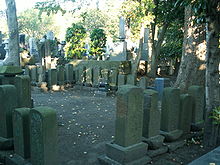- Meshimori onna
-
The graves of meshimori onna located in the precinct of Eishō-ji temple in Fujisawa city. They were built by the owner of Hotel Komatsuya in Edo era

.
Meshimori onna (飯盛女) or meshiuri onna (飯売女)[1], literally "woman serving (or selling) meal" is the Japanese term for the women who were hired by hatago inns at the shukuba (post stations) along kaidō routes in Japan during the Edo era. They were at the beginning maids servants hired by the inns, although later as traffic along the kaidō grew and competition between the inns increased, they were often engaged in prostitution.[2][3]
Many inns had prostitutes in order to attract larger number of travellers. In 1718, Tokugawa shogunate issued a law aiming at "restricting" the headcount of meshimori onna to two per inn, giving them ground to provide prostitution as silent permission.[4]
Notes
- ^ Other variants exist, such as meshimori onna (食売女).
- ^ Vlastos, Stephen (1998). Mirror of modernity: invented traditions of modern Japan. University of California Press. pp. 211. ISBN 0520206371. http://books.google.co.jp/books?id=IJDgOecLzsQC.
- ^ (Japanese)Takeuchi, Rizō (197). Nihonshi shō jiten (日本史小辞典). Kadokawa. pp. 297. ISBN N/A. http://books.google.co.jp/books?id=vJaxAAAAIAAJ&pgis=1.
- ^ (Japanese)神奈川東海道ルネッサンス推進協議会. Tōkaidō in Kanagawa (神奈川の東海道(上)〔第2版〕). Kanagawa-shimbun. pp. 212–213. ISBN 4876452652. http://books.google.co.jp/books?id=Xup94ksgGhwC.
References
- (Japanese)五十嵐 富夫1981『飯盛女―宿場の娼婦たち』(新人物往来社)
- (Japanese)宇佐美 ミサ子2000『宿場と飯盛女』 (同成社)
See also
Categories:- History of Japan
- Service occupations
- Personal care and service occupations
- Prostitution
Wikimedia Foundation. 2010.

